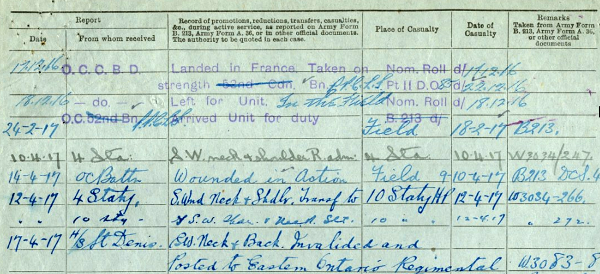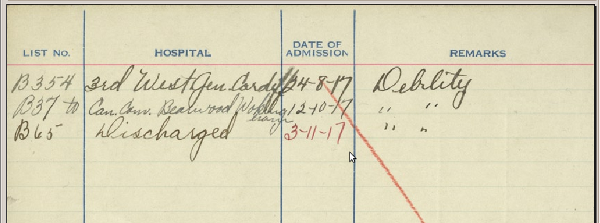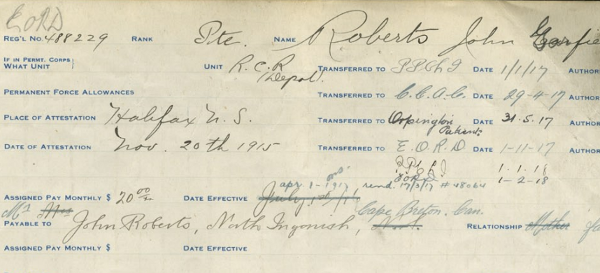
Researching Canadian Soldiers of the First World War
Part 2: The Service Record
By Michael O'Leary; The Regimental Rogue
Updated: 19 Sep 2022
Paul Marsden, in his paper Shaping the Canadian Record of War in the 20th Century, relates the circumstances which resulted in the current holdings of First World War service records at Library and Archives Canada.
Lt.-Col. Logie Armstrong, who assumed the title of Director of Records at the end of the war, … was particularly keen on this means of reducing files, claiming that the personnel files, each consisting of an overseas file and a headquarters file could be reduced to something like fifty percent of its original volume. … the Public Archives. Shortly after the Archives opened its new wing, in what is currently the Canadian War Museum, DND took the opportunity to unburden itself of the entirety of the CEF service and subject files from the OMFC and CEF. … On 1 April 1930, after much negotiation, DND transferred the records to the control of the Public Archives. … The list of actual decisions by the Public Records Committee to destroy files is a long one. However, in the context of this study there are some notable cases. As indicated above, the service files of the CEF had been transferred to custody of the Public Archives in 1930. On March 23rd 1948 the committee decided that all wartime service files would be transferred to the Department of Veterans Affairs (DVA). Colonel H.M. Jackson, then of DVA, opined that the files had no archival value and, thus, the decision was taken to allow the stripping of them. As a result, the two parts, headquarters and overseas, were consolidated by the War Service Records Division of DVA down into the single thin envelope of forms which survives today.
Shaping the Canadian Record of War in the 20th Century, published in the Canadian Military History Since the 17th Century (Proceedings of the Canadian Military History Conference, Ottawa, 5-9 May 2000)
The result of bureaucratic decision making, conflicting requirements and expectations of government departments, and the fact that the cost of destroying the files was never undertaken by agencies responsible for them, we have the benefit of the surviving records. What remains is the combined files , ie., the Overseas Miltary Forces files with Ottawa's files, for each soldier. The saved documents are generally the paperwork related to record of service, pay, pension and medical history, although other items may be found in any particular file.
Contents of the Service Records
While there are dozens of different forms that may appear in each service record, some will form the core elements of further research. Firstly, there are the record of service documents. While these may be found written on any form that came to hand, they will invariably be identified by their five columns of information:
- "Report" (further divided into two columns)
- "Date" - The date the recording HQ received the report. (Note that this is not the date of the event.)
- "From whom received" - The unit or HQ from whch the report was received.
- "Record of promotions, reductions, transfers, casualties, etc., during active service, as reported on Army Form B.213, Army Form B.36, or in other official documents." - i.e., the details, normally recorded in a very cursory fashion.
- "Date" - this is the date of event, keep in mind that the notes on record may not be shown in chronological order, this column is the important one for ascertaining the dates of events.
- "Remarks, taken from Army Form B.213, Army Form B.36, or other official documents." - This column usually has only cryptic references to the referring document.

Excerpted sample of a record of service document from the CEF service record of 488229 Private John Garfield Roberts.
The main record column, combined with the second date column, will form the central thread of the soldier's wartime history. Transcribing these and ordering them chronologically will establish dates of movements between units, periods in hospital if any, leave, and all other aspects of military life that were required to be reported to the main headquarters for the OMFC.
While that task seems simple in context, it can be challenging as you start to look over seemingly endless streams of abbreviations and short forms of unit names. But you are not the first on this path. While these instructions are a very light overview of the research you are undertaking, the members of the Canadian Expeditionary Force Study Group (CEFSG) have collected much information that will help as specific questions arise. The CEFSG, in the form of an online forum, includes a message board section specific to Service Records and, for an excellent starting point, a comprehensive and ever-growing list of Acronyms & Abbreviations found in CEF Service Records and War Diaries.
(Sep 2022) As Library and Archives Canada continues to reorganize its website, here's an updated link for their resource page for "Military abbreviations used in service files".
The Record of Service sheets will appear jumbled at first. This is the effect of having the two sets of documents (the Overseas file and the Ottawa headquarters file) put together in the one saved service record file. As you transcribe them you may find items that are recorded in one document set but not the other. A majority of items will appear twice, but any item may have a little more information on one record sheet than another.
Significant items to watch for in the Record of Service include:
Transfers. Movements between units, where the soldier is Struck off Strength (S.O.S.) of one unit and immediately Taken on Strength (T.O.S.) of a new unit.
Promotions. These may be noted as with or without the associated pay increase. See Part 11: Rank, no simple progression.
Demotions. These may also referred to as Reversions and were not always a bad thing. Although it could be a punishment, it was as often the result of a man accepting a reduction in rank to proceed overseas to France from a training or reserve unit in England. See Part 11: Rank, no simple progression.
Courts Martial. The formal trials of soldiers for crimes committed on active service. Some entries in a service record may note punishments (Mulct Pay, Forfeitures of Pay, Field Punishments) without a Court Martial, and those are the results of summary trials held before a Company Commander or Commanding Officer. Courts Martial, on the other hand, left a much more complete record, and these too can be ordered from Library and Archives Canada. See Part 3: Court Martial Records.
Hospitalizations. Men were hospitalized for sickness, accidental injury or for wounds received in action. Periods of hospitalization and subsequent recovery could be lengthy, lasting many months, even when we might today recover quickly with the benefits of modern antibiotics and other medicines. Soldiers might progress through a series of hospitals in moving from the front lines rearward, including transhipment to England by Hospital Ship, until they reached a longer term care facility.
Details of death. If the soldier was a casualty overseas, then some details of death may be recorded in his file. See Part 5: Casualties.
Medical Records
Medical documents in the service records can range from file cards noting admissions to hospital, to examination and treatment records, to examination on discharge from the CEF. These can provide a record of movements through the medical system, from the Casualty Clearing Stations near the front lines to the Convalescent Hospitals in the English countryside.
Diseases and treatments may be cause for extra research, as the naming of ailments and the noted treatments may not be the same today. Occasionally, a family researcher may want to seek out the advice of a medical professional for a more detailed understanding of their ancestor's medical conditions and the care they experienced.

Sample of a hospital admissions record card from the CEF service record of 733157 Private Robert Watson.
Pay and Pension
CEF service records will usually still contain pay ledger sheets and any documents related to final settlement of pay account and pensions or gratuities awarded at the end of the soldier's service. Pay ledgers may include the names and addresses of next-of-kin that were awarded Pay Allotments (i.e., money sent home to wife, mother, or other designated recipient.)
A more detailed examination of pay ledgers may reveal deductions for lost equipment when the loss was through negligence, minor fines such as for being absent without leave, or the loss of 50 cents per day plus field allowances while in hospital for venereal disease. While 50 cents per day may not sound like much to us today, that was half the daily rate of pay for a Private soldier.

Excerpted sample of a pay ledger from the CEF service record of 488229 Private John Garfield Roberts.
Other interesting tidbits may include large withdrawal from a soldier's pay account as he goes on leave to Paris or England, or the possibility that he seldom drew cash from his pay account and left the Army with a large sum of pay in hand.
The CEF Paper Trail
An excellent online resource providing examples of the many different documents that may be found in CEF service records is available at Brett Payne's CEF Paper Trail. The following, from his introduction, outlines the aim of his project:
"The first phase of this project has involved the collating of examples of each type of document found in a soldier's World War 1 Canadian Expeditionary Force Service Records. Here you will find a preliminary selection, and I would like to encourage other researchers to contribute more. The guide is designed partly to show prospective researchers what they can expect to find in a soldiers' service records, and partly to answer questions that I have had from fellow researchers wanting to know how they, too, can find out more of their particular soldier's military service. It's important to be aware that you will only find a selection of these records in your particular CEF soldier's file. Please note that some of these images will take a while to download if you are still on dial-up access."
Part 3 - Court Martial Records.
Researching Canadian Soldiers of the First World War
- Introduction
- Part 1: Find your Man (or Woman)
- Part 2: The Service Record
- Part 3: Court Martial Records
- Part 4: War Diaries and Unit Histories
- Part 5: Casualties
- Part 6: Researching Honours and Awards
- Part 7: Deciphering Battlefield Location Information
- Part 8: More Mapping Information
- Part 9: Matching Battlefield Locations to the Modern Map
- Part 10: Service Numbers; More than meets the eye
- Part 11: Rank, no simple progression
- Part 12: Medals; Pip, Squeak, Wilfred and the whole gang
- Part 13: Evacuation to Hospital
- Part 14: The Wounded and Sick
- Part 15: Crime …
- Part 16: … and Punishment
- Part 17: Battalions and Brigades, Companies and Corps
- Part 18: Photo Forensics: Badges and Patches
- Part 19: Veterans Death Cards
- Part 20: The Vimy Pilgrims (1936)

- The O'Leary Collection; Medals of The Royal Canadian Regiment.
- Researching Canadian Soldiers of the First World War
- Researching The Royal Canadian Regiment
- The RCR in the First World War
- Badges of The RCR
- The Senior Subaltern
- The Minute Book
- Rogue Papers
- Tactical Primers
- The Regimental Library
- Battle Honours
- Perpetuation of the CEF
- A Miscellany
- Quotes
- The Frontenac Times
- Site Map
QUICK LINKS
- Tomb of the Unknown Soldier
- Vimy Memorial
- Dieppe Cemetery
- Perpetuation of CEF Units
- Researching Military Records
- Recommended Reading
- The Frontenac Times
- RCR Cap Badge (unique)
- Boer War Battles
- In Praise of Infantry
- Naval Toast of the Day
- Toasts in the Army (1956)
- Duties of the CSM and CQMS (1942)
- The "Man-in-the-Dark" Theory of Infantry Tactics and the "Expanding Torrent" System of Attack
- The Soldier's Pillar of Fire by Night; The Need for a Framework of Tactics (1921)
- Section Leading; A Guide for the Training of Non-Commissioned Officers as Commanders and Rifle Sections, 1928 (PDF)
- The Training of the Infantry Soldier (1929)
- Modern Infantry Discipline (1934)
- A Defence of Close-Order Drill (1934): A Reply To "Modern Infantry Discipline"
- Tactical Training in the British Army (1901)
- The Promotion and Examination of Army Officers (1903)
- Discipline and Personality (1925)
- The Necessity of Cultivating Brigade Spirit in Peace Time (1927)
- The Human Element In War (1927)
- The Human Element In Tanks (1927)
- Morale And Leadership (1929)
- The Sergeant-Major (1929)
- The Essence Of War (1930)
- Looks or Use? (1931)
- The Colours (1932)
- Personality in Leadership (1934)
- Origins of Some Military Terms (1935)
- Practical Examination; Promotion to Colonel N.P.A.M. (1936)
- Company Training (1937)
- Lament Of A Colonel's Lady (1938)
- Morale (1950)
- War Diaries—Good, Bad and Indifferent
- Catchwords – The Curse and the Cure (1953)
- Duelling in the Army
- Exercise DASH, A Jump Story (1954)
- The Man Who Wore Three Hats—DOUBLE ROLE
- Some Notes on Military Swords
- The Old Defence Quarterly (1960)
- Military History For All (1962)
- Notes for Visiting Generals (1963)
- Hints to General Staff Officers (1964)
- Notes for Young TEWTISTS (1966)
- THE P.B.I. (1970)
- Standing Orders for Army Brides (1973)
- The Time Safety Factor (1978)
- Raids (1933)
- Ludendorff on Clerking (1917)
- Pigeons in the Great War
- Canadian Officer Training Syllabus (1917)
- The Tragedy of the Last Bay (1927)
- The Trench Magazine (1928)
- Billets and Batman (1933)
- Some Notes on Shell Shock (1935)
- Wasted Time in Regimental Soldiering (1936)
- THE REGIMENT (1946)
- The Case for the Regimental System (1951)
- Regimental Tradition in the Infantry (1951)
- The Winter Clothing of British Troops in Canada, 1848-1849
- Notes On The Canadian Militia (1886)
- Re-Armament in the Dominions - Canada (1939)
- The Complete Kit of the Infantry Officer (1901)
- The Canadian Militia System (1901)
- The Infantry Militia Officer of To-day and His Problems (1926)
- Personality in Leadership (1934)
- British Regular Army in Canada
- Battle Honours (1957)
- Defence: The Great Canadian Fairy Tale (1972)
- The Pig (1986)
- Standing Orders for the Fortress of Halifax, N.S.; 1908
- Medals and Badges - Fakes and Copies
- Army Punishments Part 1 - • Part 2
• C.A.R.O. No. 6719 - Campaign Stars, Clasps, The Defence Medal and the War Medal 1939-45
[an error occurred while processing this directive]
[an error occurred while processing this directive]